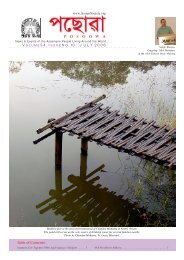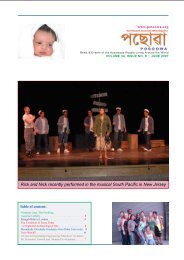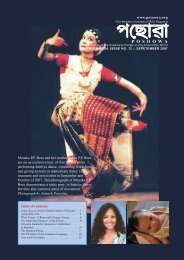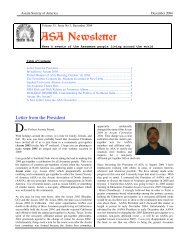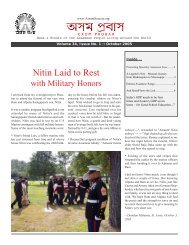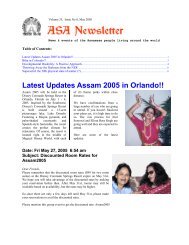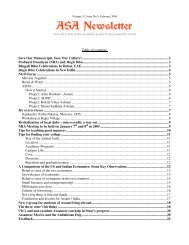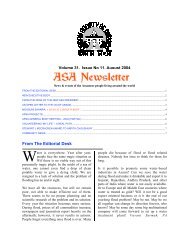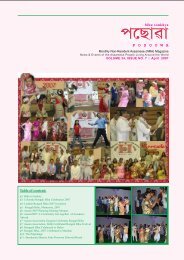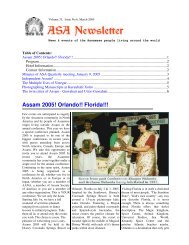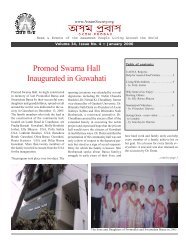Assam 2005: My Impressions - Assam.Org
Assam 2005: My Impressions - Assam.Org
Assam 2005: My Impressions - Assam.Org
You also want an ePaper? Increase the reach of your titles
YUMPU automatically turns print PDFs into web optimized ePapers that Google loves.
www.<strong>Assam</strong>Society.org<br />
News & Events of the <strong>Assam</strong>ese People Living Around the World<br />
Volume 32, Issue No.10 :: July <strong>2005</strong><br />
<strong>Assam</strong> <strong>2005</strong>: <strong>My</strong> <strong>Impressions</strong><br />
By Alpana Sarangapani, Houston, Texas<br />
We just got home from the great <strong>Assam</strong>ese<br />
get-together at Orlando, Florida held at the<br />
beautiful and elegant setting at Disney<br />
Coronado Springs resort, which we enjoyed<br />
thoroughly.<br />
Here are some of the highlights of the event<br />
(from my point of view as a member of the<br />
audience):<br />
There was no small-time politics and upstaging<br />
one another at all. Thus there was no tension<br />
and each and everyone was having plain<br />
and simple fun. It was truly a “community<br />
event” where the community was the focus,<br />
as opposed to a convention which is consumed<br />
by itself.<br />
Even though there is only one <strong>Assam</strong>ese family<br />
in the Orlando area, there are many outof-town<br />
<strong>Assam</strong>ese Floridians (and also from<br />
other states) who organized or helped in this<br />
great event for the guests to have some down<br />
to earth fun. It made us feel like it was taken<br />
care of by ‘local people’ - we were totally<br />
“at home”.<br />
Some from the crowd like, Ganesh Bora,<br />
Utpal Brahma, Partha Gogoi, Prakash Deka,<br />
Abani Sharma, Jukti Kalita, Priyankoo<br />
Sharma, Jugal Kalita, Kamal Sharma etc.,<br />
made the event much more livelier by their<br />
frequent jokes and the use of their sense of<br />
humor at the right times.<br />
Both professional artists (Elora Bora Singh<br />
and Jitul Sonowal) from <strong>Assam</strong> gave great<br />
performances as expected. We had the experience<br />
of personally talking and dining<br />
with them - never get this opportunity even<br />
back home. The guest artists were not just<br />
great performers, but were also able to mix<br />
and mingle with us freely.<br />
Before going to Orlando, we had often heard<br />
of many of the names involved and thought<br />
they were larger than life, but were pleasantly<br />
surprised that none of them had any<br />
airs about them.<br />
To add to this, we enjoyed and were extremely<br />
proud to be able to enjoy the performances<br />
of great artists from the US itself.<br />
To mention some are: Rabin &<br />
Arundhotee Goswami, Abani Sarma and his<br />
granddaughter little Ranikiran, Priya Saikia,<br />
Anjana Bordoloi, Umesh Tahbildar, Biraj<br />
Bhuyan, Chumki Gogoi, Ruprekha Bhuyan,<br />
Lona Sarma, Leoni Borkakati, Preetha<br />
Kamath, Priya Saikia, Bihu - wonderfully<br />
danced by little Jahnabi Das, Rick Bhuyan,<br />
Nick Bhuyan, Nikumani Bhuyan, Surabhi<br />
Kalita, Jukti Kalita, Nilakshi Thakuria,<br />
Jayanta Thakuria, Malabika Brahma,<br />
Moushumi Chatterjee, Anuradha Deka,<br />
Please forgive me if I missed any performer’s<br />
name. MCs: Rick and Nick Bhuyan, Pari<br />
Saikia, Santanu and Moushumi Chatterjee<br />
kept the show moving at a good pace.<br />
Rabin Goswami’s presentation was just mesmerizing.<br />
His personality filled with humility<br />
and politeness won’t give you a clue that<br />
he possesses a great voice and the quality of<br />
a professional singer, unless and until you<br />
hear him singing.<br />
The food was just great. The host families<br />
went out of the way to provide the whole<br />
gathering with sumptuous, nutritious meals<br />
Inside ...<br />
<strong>Assam</strong> <strong>2005</strong>,Disneyland,<br />
Orlando, USA . . . . . . . . . . . . . . . . . . . 2<br />
Book Review . . . . . . . ... . . . . . . . . .. .3<br />
The Passage by Sancjayota Sharma . .4<br />
London Torn into Pieces:<br />
<strong>My</strong> Heart Bleeds . . . . .. . . .. ... . .... . ..5<br />
Some Key Concepts of<br />
<strong>Assam</strong> Vaishnavism ... . . . . . . . . . .. . .5<br />
Golden Jubilee of AEC and<br />
Sustainability Issues . . . . . . . . . .. . . .. 6<br />
of a medley of American, Italian, Indian and<br />
Mexican (as opposed to the regular oily Indian<br />
restaurant<br />
food) dishes.<br />
They even paid<br />
attention to the<br />
details where vegetarians<br />
like me<br />
had a wide choice<br />
- gestures like this<br />
reinforces the<br />
feeling that each<br />
and everyone is<br />
welcome.<br />
Jitul Sonowal<br />
Then there was this unique arrangement<br />
where guests were taken by bus (a nice scenic<br />
drive) to a local Indian restaurant for a<br />
grand dinner. It was like fun mixed with food.<br />
Before I forget, we also had the pleasure of<br />
viewing a short film by Ms. Sanchayita<br />
Sharma, “The Passage”, about a poor family<br />
and their life “amidst the crisis of insurgency”.<br />
The film is bases on the award winning<br />
short story by Dr. Indira Goswami.<br />
We also got to see Sanjoy Hazarika’s A River’s<br />
Story, the Quest for the Brahmaputra, directed<br />
by Jahnu Barua. It depicted the everyday life of<br />
all the people of the countries through which<br />
the great river flows.
The gathering was also able to enjoy some<br />
of the outstanding paintings of Mahesh da<br />
(Baishya) and Ms. Jupi Tara Das’ art (paper<br />
cutting) creation. Mahesh da also took the<br />
extra time to educate us to the essence of<br />
water-color painting. The discourse was not<br />
just educational but also enabled many of us<br />
to appreciate painting and art in a more<br />
knowledgeable way. There was also a beautiful<br />
exhibiton of Some of you missed the<br />
event because of some reason or another, but<br />
we really wish you all had been there. Like<br />
us, I am sure you too would have throughly<br />
enjoyed the fun-filled events. We made many<br />
new friends, and touched base with a whole<br />
lot more.<br />
One thing other meets in future might want<br />
to learn from <strong>Assam</strong> <strong>2005</strong> is the spirit of<br />
comradrie and kinship and the utter lack of<br />
groupism, that was felt throughout the 3-day<br />
event. Its not just enough to put up a lot pomp<br />
and glitz, but the main reason we need to<br />
gettogether once in a while whether it’s for<br />
Bihus or for other events is to develop and<br />
enhance the coheshiveness of Porbaxi<br />
Oxomiya.<br />
Young children too had their share of fun in<br />
the sports and picnic - many of them were<br />
also enjoying it in a grand way at Disney.<br />
Dr. Birendra Gohain, Commissioner to the<br />
CM of <strong>Assam</strong>, was the keynote speaker on<br />
Sunday. He touched upon a number of important<br />
issues involving <strong>Assam</strong>.<br />
While describing the fun that we had at the<br />
Orlando get-together, I don’t want to leave<br />
out the names of the organizers of the event.<br />
See what I mean! These organizers did not<br />
make us feel that they are the ones who were<br />
instrumental in making this happen. They<br />
are: Mr. Sunil B. Nath, Mrs. Abha Nath,<br />
Sanjib Bhuyan, Abani Sharmah, Kanika<br />
Sharma, Ganesh Bora, Samarjyoti Kalita,<br />
and Nilakshi Thakuria.<br />
I am pretty sure I have missed somebody,<br />
then again, that is ‘coz they were really working<br />
hard for the event to go smoothly without<br />
being noticed by the regular people like<br />
us. Like I said earlier, it was truly a “community<br />
event” for the people and just not for<br />
the organizers.<br />
<strong>Assam</strong> Society of America :: July <strong>2005</strong><br />
Mrs. Sharma took the extra effort to teach<br />
the Chef of the resort center to make quite a<br />
few <strong>Assam</strong>ese dishes like, Dail, Maasor<br />
tenga, Porotha, Paleng-xaakor bhaji, Poduna<br />
Satni, etc. - <strong>Assam</strong>ese style, then providing<br />
desserts like Jilepi, Rosogullah, Lal-muhon,<br />
etc., (even the cucumbers were cut in<br />
<strong>Assam</strong>ese style – you know! not in round<br />
circles, but in small chunks, I was touched<br />
:), really!)<br />
Also, I now realize that a big percentage of<br />
the people in the get-together were the members<br />
of the <strong>Assam</strong> Society of America, but<br />
not a single soul asked us to be members of<br />
the Society, neither did they make us feel like<br />
“outsiders”, even for a second. I truly commend<br />
their gracious hospitality and thank<br />
them for a job well done.<br />
We heartily congratulate all the people involved<br />
in <strong>Assam</strong> <strong>2005</strong> for making the event<br />
a grand success.<br />
<strong>Assam</strong> <strong>2005</strong><br />
Disneyland, Orlando, USA<br />
Disneyland in Orlando, Florida, arguably the<br />
entertainment capital of the USA was the<br />
venue of ASSAM <strong>2005</strong> from July 1 st to July<br />
4 th . During that sultry summer long weekend,<br />
when the natives flocked to the beaches<br />
in droves and enjoyed their backyard barbecue<br />
parties, <strong>Assam</strong>ese families from various<br />
states of the union gathered in this USA’s<br />
Sunshine State to celebrate their ethnic heritage.<br />
Their goal was to listen to their favorite<br />
songs from the invited artists, watch their<br />
favorite dances, dance to the tune of<br />
bihugeets, enjoy a few <strong>Assam</strong>ese movies,<br />
discuss issues of importance to <strong>Assam</strong> and<br />
India, network with the fellow <strong>Assam</strong>ese<br />
expatriates and talk till the end of the night.<br />
Some of them had planned extended stays<br />
before or after the get-together to enjoy what<br />
Orlando has to offer – after all they were<br />
only steps away from the world-renowned<br />
July 1-4, <strong>2005</strong><br />
Jukti Kalita, New Jersey<br />
entertainment parks like Magic Kingdom,<br />
EPCOT Center, Sea World and the Animal<br />
Kingdom.<br />
This year’s get-together was jointly organized<br />
by the <strong>Assam</strong>ese residents of Florida.<br />
The conveners were Sunil Nath, Abha Nath,<br />
Abani Sarma, Samar Kalita, Ganesh Bora –<br />
all of Florida and Sanjib Bhuyan of New<br />
Jersey. The cultural show was put together<br />
by Nilakshi and Jayanta Thakuria of New<br />
Jersey. There were two invited artists from<br />
<strong>Assam</strong> – the immensely popular <strong>Assam</strong>ese<br />
singer Jitual Sonowal and Ellora Bora Singh<br />
who is an accomplished Xatriya and<br />
Bharatnatyam dancer. Robin Goswami from<br />
Washington DC was featured as the invited<br />
artist from within the USA.<br />
Jitual Sonowal enthralled the audience with<br />
2<br />
songs from his popular music cassettes including<br />
remixes of songs of the bye-gone era<br />
and bihugeets on both nights of the get-together.<br />
Many members of the audience got<br />
on to their feet at the tune of Jitul’s melodies<br />
and the bihu numbers. Jitul’s remixes in<br />
which he sings popular <strong>Assam</strong>ese songs to<br />
the blended Eastern and Western tunes were<br />
hit with both the young who grew up in the<br />
USA and the grown-ups. On the second night<br />
of the program Jitul invited some members<br />
of the audience like Nilakshi Thakuria and<br />
Umesh Tahbildar to accompany him for a few<br />
songs.<br />
Ellora Bora Singh who is in the US with her<br />
husband Vijay Singh performed on the second<br />
night of the get-together. Her superb<br />
Xatriya and Bhartnatyam recitals were enjoyed<br />
by all. She showed pure brilliance<br />
through her own creations in which she<br />
dances to the tune of ‘O mor apunaar dex’<br />
and the American national anthem. Despite<br />
the fact that she had arrived only a few hours<br />
before her performance from India after a<br />
long flight, she delighted everyone through<br />
her exquisite exposition of the dance forms<br />
of <strong>Assam</strong> and India.<br />
Rabin Goswami sang songs composed and
popularized by the brothers Bhupen and late<br />
Jayanta Hazarika in addition to a few Hindi<br />
songs. The expertise with which he rendered<br />
his voice to songs sung by other artists is<br />
indeed amazing. When he sang Bhupen<br />
Hazarika’s songs, he sounded exactly like<br />
the doyen of the <strong>Assam</strong>ese music. But, when<br />
he switched over to Jayanta’s songs, he transformed<br />
his voice instantly and voila’ the audience<br />
now had a Samar incarnation in front<br />
of them. Rabin’s wife Arundhati also accompanied<br />
him for a few songs.<br />
Dr. Birendra Gohain, Commissioner to the<br />
CM of <strong>Assam</strong> was the keynote speaker on<br />
Sunday. He discussed various issues regarding<br />
the development of <strong>Assam</strong> and how the<br />
current Gogoi government is trying to accelerate<br />
the process of integration of <strong>Assam</strong>’s<br />
development with the rest of India. There<br />
was a question and answer session at the end<br />
of Dr. Gohain’s presentation.<br />
Some of the other notable performances during<br />
the two days were as follows: (1)<br />
Aadhunik dance by Suravi Kalita and<br />
Nilakshi Thankuria, (2) Bodo Bagarumbaa<br />
dance by Malabika Brahma, Mausumi<br />
Chatterjee and Anuradha Deka, (3) Bihu<br />
dances by Anjana Bordoloi Hazarika, Priya<br />
Saikia, Jahnabi Das, Nikumani Bhuyan and<br />
Jayanta Thakuria, (4) Oddissi dance by Leoni<br />
Barkakati, (5) Bhartnatyam by Loni Sarma,<br />
(6) Old Hindi and <strong>Assam</strong>ese songs of 1930s<br />
to 1950s by Abani Sarma. (7) Dances to the<br />
tune of Bhupen Hazarika’s songs by Sumki<br />
Gogoi, (8) <strong>Assam</strong>ese songs by Umesh<br />
Tahbildar and Biraj Bhuyan, (89 <strong>Assam</strong>ese<br />
and English songs by Rupak Bhuyan and<br />
Neepak Bhuyan, and (10) <strong>Assam</strong>ese songs<br />
by Ruprekha Bhuyan. The functions were<br />
emceed by teenagers Rupak Bhuyan, Neepak<br />
Bhuyan and Priya Saikia on the first night<br />
and on the second night by Shantanu and<br />
Mausumi Chatterjee. Both nights featured<br />
mukoli bihus.<br />
A magazine called Asomi <strong>2005</strong> as well as<br />
souvenir was brought out on the occasion of<br />
the <strong>Assam</strong> <strong>2005</strong> celebrations. Asomi <strong>2005</strong><br />
which has sections in <strong>Assam</strong>ese and English<br />
featured articles by writers from the USA as<br />
well as <strong>Assam</strong>. It was edited by Jukti Kalita<br />
while the souvenir was edited by Sanjib<br />
Bhuyan. Pre-conference communications including<br />
several newsletters to the community<br />
were prepared by Jugal Kalita, Probal<br />
Tahbildar and Prakash Deka.<br />
There was a display of art by Jupi Tora Das<br />
<strong>Assam</strong> Society of America :: July <strong>2005</strong><br />
of Pennsylvania, Mahesh Baishya of California<br />
and Dadul Chaliha of Mangaldoi,<br />
<strong>Assam</strong>. Jupi Das has set up her own studio<br />
in Harrisburg, the capital of Pennsylvania<br />
and regularly participates in the arts and<br />
crafts shows in the north-eastern USA. Mr.<br />
Chaliha, though not personally present, had<br />
sent several pieces of his art for display. He<br />
is an upcoming artist and had already held<br />
shows not only in <strong>Assam</strong>, but also in various<br />
parts of India including in New Delhi,<br />
Calcutta and Amritsar. Krishna Hazarika of<br />
Maryland designed the tasteful banner of<br />
<strong>Assam</strong> <strong>2005</strong>.<br />
Biraj Bhuyan, a prominent <strong>Assam</strong>ese businessman<br />
from Pennsylvania was so enthralled<br />
by <strong>Assam</strong> <strong>2005</strong> that he volunteered<br />
to personally sponsor multiple artists for the<br />
next convention, the venue for which will<br />
soon be decided upon. Everyone attending<br />
the conference was highly pleased with the<br />
hospitability of world renowned Walt<br />
Disney. The cooks at the Disney’s restaurants<br />
had prepared excellent <strong>Assam</strong>ese and<br />
Indian dishes based on the directions of a<br />
few of the participants. Everyone carried<br />
wonderful memories back to their homes.<br />
Book Review:<br />
Heritage Guwahati by<br />
Dipankar Banerjee<br />
Recently, I was reading a book called Heritage<br />
Guwahati, written by Dipankar Banerjee,<br />
professor of History in Gauhati University. In<br />
this book Professor Banerjee in association<br />
with Kamrup (Metropolitian) District Association<br />
narrates some of the historic landmarks of<br />
the city of Guwahati which themselves have a<br />
heritage of their own. The list includes some<br />
prominent landmarks like Northbrook Gate;<br />
Bijulee Cinema,; Cotton Collegiate; Kamrup<br />
Anusandhan Samiti; Kasturba Ashram;<br />
Harishaba; Cotton College; Dighalipukhuri;<br />
Bura Majid; Handique Girl’s College;<br />
Mahafezkhana; Arya Natya Samaj; DHAS;<br />
Sikh Temple; Earle Law College, Kelvin<br />
Cinema; Barpeta Sakha Satra; GMC; Bengali<br />
HS School; J Barooah’s Bungalow; Brahmo<br />
Samaj; Rasul Lodge; Borgola; The Gauhati<br />
Club; Umananda; Curzon Hall; Satribari<br />
Christian Hospital; Kumar Bhaskar Natya<br />
Mandir; Saikh Brothers; Baptist Church; DC’s<br />
Bungalow; KB Banerjee & Sons; Maharana<br />
Club; Cotton Principal’s Bungalow;<br />
Harikrishna Das’ House; and Kamrup Academy.<br />
By reading the book I came across a lot of<br />
information. For example the first silent movie<br />
was screen in the city in a small hall opposite<br />
Nag Kota Pukhuri later named as Bijulee<br />
Cinema. Amalprabha Das with the help of her<br />
illustrious father Dr Harikrishna Das built the<br />
Kasturba Ashram according to Gandhiji’s<br />
wishes. The Harisabha Trust was created by<br />
people from different communities for religious<br />
discourses and other festivals in 1913. The<br />
Mahafezkhana (Record Room) was established<br />
between 1855 and 1865. The Arya Natya<br />
Mandir attracted some of the icons of the<br />
socio-cultural, political and literary life of<br />
India. The department of Historical and<br />
Antiquarian Studies (DHAS) was established<br />
to promote knowledge of history. The Sikh<br />
Mandir was established in 1904-05 and Kelvin<br />
Cinema 1935. The Guwahati Municipal<br />
Corporation was started under the 1850 Bengal<br />
Municipal Act. The Brahmo Mandir was<br />
constructed in 1901 from a plot of land<br />
acquired by the government. The Curzon Hall<br />
was constructed in 1912 to commemorate<br />
Governor General Lord Curzon’s visit in 1900.<br />
In 1885, three brothers from Calcutta established<br />
the Shaikh Brothers bakery in Panbazar.<br />
The Maharana Club<br />
was established in<br />
1907 by ten youths.<br />
In addition there are<br />
lot more information<br />
that Professor<br />
Banerjee shares with<br />
the readers. The book<br />
edited by, Monideepa<br />
Choudhuri, contains a<br />
preface by Prime<br />
Minister Dr Manmohan Singh. In his words,<br />
Dr. Singh calls Guwahati a ‘city of great beauty<br />
with affectionate people who have lovingly<br />
built the city into a brilliant mosaic of<br />
cultures’. The Deputy Commissioner of<br />
Kamrup (Metropolitian) District, A K Asbar<br />
Hazarika, says that the city’s scenic splendor,<br />
way of life and architecture has won over over<br />
the heart and delighted the soul. The book is<br />
worth reading for all those who love Guwahati.<br />
- Contributed by Satyam Bhuyan, Ames,<br />
Iowa. The writer is a graduate student at<br />
Iowa State University, Ames, Iowa.<br />
3
The Passage by Sanchayita Sharma<br />
Not too long ago today I watched<br />
your film “The Passage,” and despite<br />
my lack of expertise as a film critic,<br />
I want to say that Sanchayita has done<br />
a fantastic job in your first attempt. I<br />
was very moved by the scene when<br />
“Atoi” touches Pokhili’s bloodied<br />
face towards the end of the film - I<br />
don’t know how Sanchayita was able<br />
to do it, but the expression in his face<br />
tells many many untold stories of<br />
pain, suffering, helplessness, and<br />
human suffering in general. Kudos<br />
for able to bring up some imp issues<br />
that <strong>Assam</strong> and its people are facing<br />
in your film. Thank you for letting<br />
us screen the film at <strong>Assam</strong><strong>2005</strong> –<br />
on behalf of everybody involved in<br />
it, I thank you sincerely.<br />
It is our misfortune that Sanchayita<br />
will not be there in person to show<br />
the film, but we did our best to<br />
present the film, including distributing<br />
a short flier on Sanchayita and<br />
her film.<br />
Here in NJ, I’m involved in Rutgers<br />
University’s South Asia program -<br />
with your permission, I can ask them<br />
if they’d like to screen the film (either<br />
during summer or in fall). I can<br />
be there in the screening and explain<br />
the background. There is one Aytree<br />
Phukan, a doctoral student in English<br />
comp lit, who is also associated with<br />
the South Asia program and may be<br />
also help.<br />
Again, we missed Sanchayita in Orlando,<br />
but we thank her very much<br />
for letting us show her work. I’m<br />
confident that her future is quite<br />
bright and I’m sure others agree.<br />
- Sanjib Bhuyan, New Jersey<br />
-<br />
<strong>Assam</strong> Society of America :: July <strong>2005</strong><br />
Sanchayita’s Response:<br />
I am glad that you enjoyed the film.<br />
Yes, for a non actor Atoi was excellent<br />
in that shot. All I did was talk<br />
him through the pain involved while<br />
he was giving the shot and he didn’t<br />
let me down. The lighting was good<br />
too which helped to see the creases<br />
in his Eri and the lines on his forehead.<br />
I does have a lot of character<br />
on his face was one of the strong<br />
points for casting him. The map of<br />
his face tells a story about his pain<br />
and simplicity which sometimes you<br />
don’t get on an actor’s face. I purposely<br />
didn’t rehearse this shot and<br />
wanted to catch him off guard and I<br />
think, for him, it came from within. I<br />
was lucky too as he is indeed a genuine<br />
man in a world where a lot of<br />
people do a lot of things in the name<br />
of God. I believe that good people<br />
can be good actors.<br />
On a lighter side, off and on, in his<br />
namghar Atoi gives prayers in my<br />
name and dutifully delivers proxad<br />
to my mom and catches up about me.<br />
Bless.<br />
<strong>Assam</strong> <strong>2005</strong> Photos<br />
Suravi Kalita and Nilakshi Thakuria,<br />
both of New Jersey, danced to an<br />
<strong>Assam</strong>ese song during <strong>Assam</strong> <strong>2005</strong>.<br />
Biraj Bhuyan and his wife Hansa pledged<br />
$10,000 to bring in artists from <strong>Assam</strong> for<br />
<strong>Assam</strong> <strong>2005</strong>. Biraj Bhuyan is a Pennsylvania<br />
businessman who deals in diamonds. Currently,<br />
he is involved in building a chain of small<br />
motels called Stop Inns (http://stop-inn.com)<br />
across the US.<br />
Rabin Goswami of Washington,<br />
DC, sang songs of Dr.<br />
Bhupen Hazarika and others.<br />
He sounds exactly like Dr.<br />
Hazarika! His wife Arundhoti<br />
Goswami also joined him for a<br />
few songs.<br />
Elora Bora Singh performed<br />
Xottriya as well as<br />
Bharat Natyam on the<br />
second evening of <strong>Assam</strong><br />
<strong>2005</strong>. She and her<br />
husband had arrived only<br />
a few hours earlier from<br />
<strong>Assam</strong>.<br />
4
<strong>Assam</strong> Society of America :: July <strong>2005</strong><br />
London Torn into Pieces:<br />
<strong>My</strong> Heart Bleeds<br />
On Thursday morning I took the tube from Baker<br />
street to Whitechapel station my usual route to<br />
work. I was lucky to got off in time 10 minutes<br />
away from Liverpool station, when the bomb<br />
blast. I was holding onto my Saibaba locket and<br />
prayed for saving my life.<br />
This is the second time that I have been caught<br />
up in a major disaster and to be honest, I am feeling<br />
very shaky.<br />
Inspite of the massive difference in surroundings<br />
there have been uncanny similarities with the<br />
bomb explosion at Ganeshguri Market, Dispur<br />
few years back where I was shopping on that fatal<br />
day.<br />
The same bewildered expression of innocent<br />
people stunned by sudden horror. The same creeping<br />
realisation that people are dead and dying.<br />
I can't believe that such barbarism should come<br />
the day after the national euphoria at winning the<br />
Olympics. It is desperately sad. And especially<br />
when G8 Summit of world leaders gathered for<br />
its mission to make poverty history.<br />
Terrorist on this earth don't care about anyone.<br />
Their killing is indiscriminate. Edgeware Road<br />
is full of Arabs, Aldgate has many Asians and<br />
predominately Muslims. How our earth anybody<br />
can really believe that God is pleased with this,<br />
that killing innocent people will earn them a place<br />
in Heaven. Every act of terrorism in the name of<br />
religion is wrong and does damage to those practising<br />
it.<br />
Walking down Oxford street you feel like you<br />
are in Park street, Chowringee, Kolkata. The<br />
Salwar Kameeze is as ubiquitous as the cropped<br />
top jeans ensemble and you can hear as many<br />
snatches of Hindi, Gujarati, Punjabi and Bengali<br />
as you do of English. This is an example of that<br />
much vaunted British multiculturalism.<br />
It is not just holidaying that appeals. When rich<br />
non-resident Indians -- whether it's L.N. Mittal<br />
or Naresh Goyal -- have to choose a baseout of<br />
where to operate it's always London that makes<br />
the cut.<br />
Partly of course it is that our easy familiarity with<br />
English makes it much easier to work and live<br />
here. But also the pace of life here is much more<br />
civilised when compared to say the frenetic energy<br />
of New York.<br />
Small wonders then that London has become the<br />
spiritual home away from home for most of us.<br />
It's the Indian punters who are the high rollers<br />
and it's their money that keeps the tills ringing.<br />
The British may have colonised us for several<br />
centuries. But it's taken us only a few deceased<br />
to take over their capital and make it our own.<br />
Some Key Concepts of <strong>Assam</strong> Vaishnavism<br />
Dr Archana Barua<br />
I made an attempt at understanding some<br />
key terms of <strong>Assam</strong> Vaishnavism like Deva,<br />
Guru, Nâm, Bhokot etc. in the background<br />
of <strong>Assam</strong>’s socio-cultural perspective and<br />
that in the wider perspective of<br />
Wittgenstein’s linguistic philosophy that<br />
relates meaning of words and terms into a<br />
socio-cultural context or what he identifies<br />
as a ‘form of life.’ In my dissertation, I sought<br />
to make a comparative study of some of the<br />
key concepts of <strong>Assam</strong> Vaishnavism, identifying<br />
it as a form of life that has its own<br />
rules for playing a particular language game.<br />
This was an attempt at understanding what<br />
specific connotation the term Deva (God)<br />
has within <strong>Assam</strong> Vaishnavism even if that<br />
Deva is called Krishna, Râma, Mahâpuruxa,<br />
and so on. Does this concept have similar<br />
meaning within other forms of Vaishnavism,<br />
say , within the Chaitanyite form ,that is also<br />
known as Bengal Vaishnavism, irrespective<br />
of the fact that all these terms refer to one<br />
common Godhead who is also the Deva of<br />
the Gita, and of the Bhagavat Purana?<br />
<strong>My</strong> special focus was on the distinctive<br />
shades of meaning that is culture and context<br />
dependent, based on that one can use<br />
Wittgenstein’s terminology and say that the<br />
British are the most tolerant nation in the world.<br />
And it is the best country to live in. We knew<br />
after 9/11 then Madrid and next us but do not<br />
know when.<br />
For a few blissful hours we were the envy of the<br />
world, the place to be. Britain was the double<br />
winner that had staged the inmensely successful<br />
Live 8 concert and became the winner of hosting<br />
the 2012 Olympics. Thursday atrocities in London<br />
once more brought out the best of Britain.<br />
I salute the heroes of the Ambulance Services,<br />
the paramedics, the police, the fire brigade, doctors<br />
and nurses who gave of themselves to save<br />
life.<br />
- Rini Kakati, London<br />
grammar of the concept of Deva decides<br />
what particular religious game is to be<br />
played and in what form. Within the context<br />
of Bengal Vaishnavism of Sri Chaitanya,<br />
bhakti becomes more eroticised and passionate,<br />
Krishna, the Deva, is incomplete without<br />
His own blissful enegy, hladini sakti that<br />
is symbolized by Radha. Within the agriculture<br />
based and the comparatively catholic<br />
and mostly non-priest oriented socio-cultural<br />
context of <strong>Assam</strong> Vaishnavism,<br />
Shankaradeva and Madhavadeva, concentrated<br />
more on Dasya and Sakhitva than the<br />
passionate and intimate love of Krishna, accordingly<br />
the Lakshmi-Vishnu form of the<br />
Deva centered round a chaste and domestic<br />
image of the Deva who is equal to all the<br />
gopies in the Râsa Leela, without any spe-<br />
...continued in page 7...<br />
5
<strong>Assam</strong> Society of America :: July <strong>2005</strong><br />
Golden Jubilee of AEC and<br />
Sustainability Issues<br />
Dr Atul Bora<br />
The journey of <strong>Assam</strong> Engineering College<br />
began in 1955 as the <strong>Assam</strong> Civil Engineering<br />
College from the <strong>Assam</strong> Engineering<br />
Institute’s campus of Chandmari, Guwahati.<br />
Late Bishnu Ram Medhi, the then Chief<br />
Minister of <strong>Assam</strong> laid the foundation of<br />
the main college building at Jalukbari on<br />
25th Jan 1956. The College got shifted from<br />
Chandmari to Jalukbari on 1st June 1957 and<br />
renamed as <strong>Assam</strong> Engineering College. The<br />
college was formally inaugurated on 16th Jan<br />
1958 by the then Prime Minister Pandit<br />
Jawaharlal Nehru. The college celebrated the<br />
first Re-union of its ex-students on 25th Jan<br />
1966. The Silver Jubilee of the college was<br />
celebrated on 6th & 7th March 1981, although<br />
1980 was the Silver Year of the college.<br />
In the light of the Silver Jubilee Year<br />
of the college, its Golden Jubilee Year is<br />
<strong>2005</strong> and the college is all set to celebrate<br />
the occasion with various events earmarked<br />
in different dates starting from 25th Jan <strong>2005</strong><br />
to 25th Jan 2006.Celebrationis focused for<br />
expanding the range of opportunities of the<br />
students along with the all round development<br />
of the institution for sustenance of<br />
AEC’s glory and relevance.<br />
Geographically, <strong>Assam</strong> and the sister states<br />
of North East India is a relatively remote and<br />
obscure part of this great country. Of late,<br />
the popular perception of negligence and<br />
underdevelopment of the region has found<br />
recognition almost at all levels. On the other<br />
hand the issue of negligence and underdevelopment<br />
of the region needs to be addressed<br />
by proactive local initiative instead<br />
of usually adopted reactive posture. Here,<br />
the indigenous capability to analyze, prioritize<br />
and solve the local set of problems<br />
arises. Thus, the state needs to develop a<br />
brand of youths with technological and<br />
managerial capability either for productive<br />
use of local natural capital or for management<br />
of natural hazards endowed. The <strong>Assam</strong><br />
Engineering College in particular and the<br />
higher educational institutions in general are<br />
supposed to shoulder these responsibilities<br />
in the state’s perspective. Thus the deeprooted<br />
relevance of AEC that determines the<br />
technological contours of the indigenous<br />
youths is evident. So, unless AEC is developed<br />
to cope with the course of time or any<br />
reluctance for investment in AEC would<br />
imply only the lack of a focused agenda for<br />
sustainable development of the state. In other<br />
words, Golden Jubilee celebration of AEC<br />
calls for a socio-political awareness about<br />
the need of institutional sustainability of the<br />
state, as a precondition for sustainable development.<br />
Today, government is too occupied to the<br />
pressing needs of immediate attention, be it<br />
terrorism or be it the service conditions of<br />
its employees. On the other hand, the individual<br />
teacher’s role in higher educational<br />
institutions is narrowed down around a subject<br />
of specialization with loss of sight to<br />
overall institutional objectives, not to speak<br />
about the state’s perspective with which these<br />
institutions were originally established. To<br />
come out from such a complex and bleak<br />
scenario, the only option left is to link the<br />
state’s higher education and scientific establishment<br />
to the state’s agenda for sustainable<br />
development. This is also the fundamental<br />
step to handle unemployment of youths in<br />
one hand and for productive utilization of<br />
employed youths on the other hand.<br />
With the occasion of Golden Jubilee, time<br />
has come for formal commemoration and<br />
introspection of AEC’s standing for the last<br />
fifty years. A brain storming session on the<br />
introspection and growth orientation of the<br />
college is an important aspect of celebration.<br />
However, as the pioneer in technical education<br />
of the North Eastern Region, AEC represents<br />
the status of the higher education<br />
sector of the state. With such a perspective,<br />
the occasion of Golden Jubilee Celebration<br />
of AEC is also an occasion for introspection<br />
and growth orientation of the entire higher<br />
education sector of the state. The situation<br />
dictates such an exercise and would be possible<br />
only with the active participation of<br />
intelligentsia and policy makers of the region..<br />
For AEC Alumni: Golden Nostalgia AEC <strong>2005</strong><br />
<strong>Assam</strong> Engineering College, Guwahati<br />
does not need any introduction to you<br />
being an alumnus of the college. But what<br />
probably needs to be said is that this<br />
almamater of our completes 50years on<br />
7th September <strong>2005</strong>. On this date in 1955,<br />
Late Shri Hari Prasad Baruah joined as<br />
the first Principal of the first Engineering<br />
College tobe established in <strong>Assam</strong>. As an<br />
act of remembering that land mark day,<br />
ex-students as well as present and past<br />
faculty members have now cometogether<br />
to celebrate this occasion in a befitting<br />
manner on 7th through 10th September<br />
<strong>2005</strong> with a programme christened<br />
“Golden Nostalgia AEC <strong>2005</strong>”. Amongst<br />
other things, we are planning to hold a<br />
symposium on “Technological Vision<br />
2025: AECIANS on the Road Map” on 8th<br />
September <strong>2005</strong> at Guwahati.<br />
With kind regards.<br />
Yours faithfully,<br />
Prof. U Miri<br />
Shri Gajendra Nath Khound<br />
Jt. Convenor<br />
SymposiumSub-Committee<br />
Golden Nostalgia AEC <strong>2005</strong><br />
6
It is a matter of concern that many private<br />
buildings have grown up in the very lowlying<br />
area within the heart of the college.<br />
Apart from distorting the unique feature of<br />
the college campus, the environmental and<br />
academic sustainability of this premier institution<br />
is at stake unless appropriate measure<br />
is not taken immediately to this end. The<br />
state government may enforce existing land<br />
use regulation to stop private settlements<br />
within the heart of the college even without<br />
any resource consumption. The option of<br />
purchasing private land within the AEC campus<br />
and allotting the same to the college<br />
should also be considered without delay to<br />
protect the immediate and long-term interest<br />
of this capacity building center of the<br />
region.<br />
Today, infrastructure of AEC is poorer than<br />
what existed twenty years back! The physical<br />
infrastructure plays a significant role on<br />
the overall organizational behaviour and<br />
personality. However, an improved physical<br />
infrastructure alone will lead us nowhere<br />
unless the same is correlated with a vision<br />
plan. As such formulation of a vision plan<br />
and commensurate infrastructure-need for<br />
the college is one of the Golden Jubilee<br />
Events. A comprehensive proposal should<br />
follow for sponsorship of relevant central<br />
government’s agencies. Homework by the<br />
college community and moral support from<br />
government are the key to this end. Efforts<br />
have also been directed to explore the possibility<br />
of overcoming the fund crunch of<br />
state through various supportive measures<br />
<strong>Assam</strong> Society of America :: July <strong>2005</strong><br />
from the corporate citizens of the region.<br />
Popular demand for modernization of AEC<br />
& JEC along with the state’s medical colleges<br />
under PM’s package should be raised.<br />
One central question is, vision plan of AEC<br />
must have linkage to the state’s vision for<br />
overall sustainability! As such, formulation<br />
of a local agenda of sustainable development<br />
with regional perspective is a logical beginning.<br />
Of course, it is only a visionary leadership<br />
that can pave the way of linking state’s<br />
higher educational institutions and scientific<br />
establishment to the state’s agenda for sustainable<br />
development.<br />
Some Key Concepts of <strong>Assam</strong> Vaishnavism<br />
.. contd. from page 5..<br />
cial preference for a particular devotee. This<br />
democratic spirit of <strong>Assam</strong> Vaishnavism is<br />
reflected in popular sayings ‘Rou barali<br />
xoroki g’ol, puthi kholihona jâlot ro’l’, (that<br />
the net of Vaishnavism in <strong>Assam</strong> could not<br />
catch big fish), it was rather aimed at not<br />
catching big fish into its fold. With strong<br />
emphasis on the Four Realities Deva, Guru,<br />
Nâm and Bhokot, with more emphasis on one<br />
or the other of the realities in the respective<br />
Sotros, for example, the Kâla Samhati established<br />
by Gopal Âta, and its centrality of<br />
Bhokot (devotee), the Deva, , there was<br />
scope for more equality of all the devotees<br />
irrespective of caste and creed, the Satra<br />
could attract large number of devotees into<br />
its fold which later strengthened the spiritual<br />
bond of all fellow devotees under the<br />
banner of Ek Saran Nâm Dharma.<br />
Within the liberal sect of Kâla Samhati , with<br />
its centrality of Hari Bhakat, large number<br />
of tribes of upper <strong>Assam</strong> found easy access<br />
to the liberal and modified form of<br />
Mohapuruxia dharma that made bhakti easily<br />
accessible to one and all with ‘Nâbasé<br />
Nâmé jâti ajâti’..! Equally significant is<br />
Gopal Âta’s attempt at liberalizing bhakti<br />
with concession made to some form of meat<br />
eating ,use of rice beer (xaj pani) etc. among<br />
some plains tribes of <strong>Assam</strong>, if that happened<br />
to be the existing custom of the tribe ,provided,<br />
they would gradually modify those<br />
practices in order to be promoted to the status<br />
of Modhyom Bhokot, Uttom Bhakat , and<br />
so on. This naturally gave enough cause for<br />
resentment against the liberal principles of<br />
Kâla Samhati by some other sects of<br />
Vaishnavism saying that the sect here has<br />
gone West! But it was the catholicity of this<br />
particular Samhati, along with some others<br />
of its kind, that was mostly responsible for<br />
bringing large number of devotees into the<br />
fold of <strong>Assam</strong> Vaishnavism, including a<br />
large number of Ahom devotees in upper<br />
<strong>Assam</strong>. It was interesting to find how the<br />
democratic spirit of <strong>Assam</strong> Vaishnavism appealed<br />
more to all sects of common people<br />
irrespective of caste and creed as they could<br />
share spiritual ties with one another as Hari<br />
Bhokot that kept room for caste mobility in<br />
a great way. For example, a xornia father<br />
refused to dine with his own axornia son but<br />
they became soul mates (Atai/Atma Rama)<br />
with anyone from another caste or creed as<br />
Hari Bhokots.<br />
Within the Smarta system ,it is the Deva,<br />
the Lord, who is special to a particular devotee,(<br />
In Bengal Vaishnavism Radha is central<br />
in the Râs Leela), while in the Bhâgavat<br />
Purân centric non priest <strong>Assam</strong> Vaishnavism<br />
Krishna in the Ras-Leela is equal to all the<br />
Gopies as this is more the democratization<br />
of bhakti than the tightening of the caste<br />
structure within its fold. That led Xoangkoro<br />
Deva and others to opt for a non idol centric<br />
but Guru , Nâm and Bhakat centric catholic<br />
bhakti scheme with innovation to select<br />
a Guru from any eligible community, eligible<br />
not in terms of high caste ,but in terms of<br />
fulfilling the required norms laid down by<br />
the Gurus(Xorono, Bhojono , etc.) that once<br />
enabled Naga’s Norottam, Javanar<br />
Chandasai, Garor Govinda, among others,<br />
to be as perfect a Guru as anyone from the<br />
so-called high caste of the society. Naturally,<br />
it evoked mixed response from different sections<br />
of the society as a result of which after<br />
the demise of the Gurus (Dujona Guru),<br />
changes were incorporated among all the<br />
sects of <strong>Assam</strong> Vaishnavism to make it more<br />
acceptable among the pan Indian Hindu social<br />
and cultural milieu with the tightening<br />
of caste hierarchy etc. that gradually.<br />
Dr. Archana Barua is an Associate<br />
Professor of Philosophy in Department of<br />
Humanities and Social sciences, at Indian<br />
Institute Of Technology Guwahati. She is<br />
the Chair (1998 to present) of the<br />
Department of Humanities and Social<br />
Sciences at the IIT. Her areas Of specialization<br />
are Phenomenology, Applied<br />
Ethics, Comparative Philosophy. She is<br />
the author of The Tradition of Religion in<br />
<strong>Assam</strong>” published by Pustak Mahal (July<br />
15, 2004). She recently presented a paper<br />
titled Designing Humans (May 29–30,<br />
<strong>2005</strong>) at the University of Western<br />
Ontario.Technology and the Changing<br />
Face of Humanity Conference.<br />
7
This is an<br />
Official Publication of<br />
<strong>Assam</strong> Society of America, USA<br />
The ASA Newsletter is published monthly. Sanjib Bhuyan, NJ, on behalf of <strong>Assam</strong> Society of America, has published<br />
this issue of ASA newsletter. The editors are Satyam Bhuyan (Ames, Iowa), Ganesh Bora (Lake Alfred, Florida), Prasenjit<br />
Chetia (Atlanta, Georgia), Babul Gogoi (New Delhi, India), Jugal Kalita (Colorado Springs, Colorado, Editor-In-Chief),<br />
Symanta Saikia (Wichita, Kansas), Vavani Sarmah (Secane, Pennsylvania), Ujjal Pathak (Baton Rouge, Louisiana), Rini<br />
Kakati (London, UK), Umesh Sharma (Cambridge, Massachusetts), and Ram Sarangapani (Houston, Texas). The ASA<br />
Executive Committee is composed of Sanjib Bhuyan, President (Franklin Park, New Jersey), Utpal Brahma, Vice President<br />
(Burlington, New Jersey), Ganesh Bora, General Secretary (Lake Alfred, Florida), Probal Tabhildar (Kendall Park,<br />
New Jersey), Mantu Baishya (Omaha, Nebraska), Kedar Bhuyan (Mays Landing, New Jersey), and Sangeeta Duorah<br />
(California).<br />
We invite contributors from all over the world. We appreciate your valuable feedback, comments & suggestions, and of<br />
course, news from your part of the world for inclusion in the coming editions. Please send your written contributions to<br />
asanewsletter@yahoo.com. If you prefer, you can send your contributions directly to any of the editors listed above as<br />
well. Any contribution must be 750 words or shorter in length. Please include a scanned image of the author. We also<br />
request you to submit other pertinent photographs if possible.<br />
<strong>Assam</strong> Society of America<br />
PO Box 254<br />
Mays Landing<br />
NJ 08330<br />
USA




